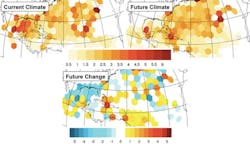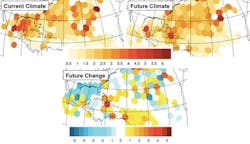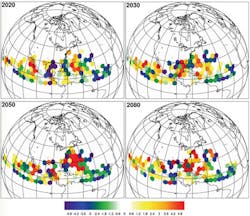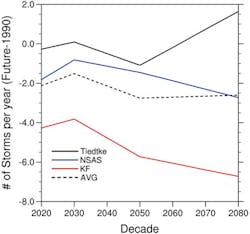Recent storm modeling data can improve offshore engineering design
Greg Holland
National Center for Atmospheric Research
Roy Long
National Energy Technology Laboratory, US Department of Energy
A recent research project carried out by the National Center for Atmospheric Research (NCAR) under the Research Partnership to Secure Energy for America (RPSEA) program, with financial support from the National Energy Technology Laboratory, a division of the US Department of Energy, generated a combination of observational analysis and statistical and dynamical modeling that produced new views of tropical cyclone activity in current and future climates. For tropical cyclone frequency, a new statistical downscaling tool applied to a climate model ensemble projects a future increase over the North Atlantic.
However, for the sub-region of theGulf of Mexico, a dynamic model ensemble projects a future decrease in hurricane frequency. The latest science therefore shows low confidence in changes in tropical cyclone frequency for the Gulf of Mexico. However, there is higher confidence on changes to tropical cyclone intensity. For tropical cyclone intensity, a new statistical-dynamical tool shows a future increase in the proportion of major hurricanes for the North Atlantic. Observational analysis indicates this change has already started on global scales.
The inclusion of tropical cyclone parameters of size and translation speed, in addition to wind speed and frequency, allows cyclone damage potential (CDP) assessments that are more relevant to industry impacts. The plausible future scenario of increased wind speed and decreased size applied to historical Gulf of Mexico hurricanes leads to overall future increases in the extremes of metocean variables, with the biggest proportional increase in the significant wave height. In agreement, the CDP applied to a dynamic model ensemble projects future increases in the maximum damage potential for distinct locations in the North Atlantic and the Gulf of Mexico. They also find substantial decadal variation superimposed on the longer-term signal.
This three-year project proceeded in three phases, each phase lasting one year. This report summarizes the major accomplishments of Phase 3. The prime contractor, the University Corporation for Atmospheric Research (UCAR), manages the NCAR on behalf of the National Science Foundation to address pressing scientific and societal needs involving Earth-system science.
Project overview
According to recent assessments, hurricane intensity is likely to increase in the future. Specifically, global average hurricane wind speeds are expected to increase, along with the proportion of major hurricanes. If true, this will have far reaching impacts on the offshore oil and gas industry. It also raises the possibility that new coastal and offshore facilities are being under-designed, and that older facilities may need hardening in order to maintain presently accepted risk levels. This project provided new credible projections of changes in hurricane activity and industry impacts in the Gulf of Mexico that have the potential to mitigate costs and minimize environmental and safety risks.
This study follows a prior RPSEA project on the effects of climate variability and change in hurricane activity in the North Atlantic. The results of this prior work contributed to ongoing debate in the scientific community on the expected future change in North Atlantic tropical cyclone frequency. Some studies suggest a future increase while others suggest a future decrease. This project aimed to quantify future changes in the frequency, duration, and intensity of Gulf hurricanes and their impacts using a powerful combination of the latest theoretical, statistical, and enhanced dynamic modeling capability. Next generation atmosphere-ocean coupled, multi-scale modeling systems were configured together with the statistics of extremes specifically to provide projections of hurricane characteristics critical to engineering design, production efficiency, safety, and environmental protection for the offshore oil and gas industry. Confidence levels in the results were established using multiple independent techniques, advanced statistics, and targeted sensitivity analysis.
The major accomplishments of Phase 1 included:
- A tool to explore empirical relationships between hurricanes and their environment
- Extreme value assessments of future changes in the exceedance probability of major hurricanes
- Evidence for a saturation in the proportion of major hurricanes, with further warming potentially seeing no further increase in the proportion of major hurricanes
- Cyclone damage potential forecasts made in real-time for Isaac and Sandy (2012), and used by the reinsurance industry to assess potential damages in advance of landfall.
The major accomplishments of Phase 2 included:
- Combined decision tool development with statistical downscaling techniques
- Credible bounds on annual North Atlantic tropical cyclone frequency and general locations of tropical cyclone activity in current climate established.
- Wind-wave-current simulations of historical hurricane cases under current conditions and future scenarios
- Proven regional modeling capacity with the new NCAR model for prediction across scales (MPAS).
Establishing confidence in hurricane projections
Sensitivity studies have been conducted to explore levels of confidence in today’s hurricanes and uncertainty in the future change in hurricanes, and relationships between the two. A 24-member dynamic model ensemble simulation of current climate hurricane activity was generated to assess the range of hurricane activity possible under current climate conditions, by expanding the historical record. Each ensemble member differs by a slightly different representation of physical processes, such as radiation, microphysics, surface boundary layer, and deep convection. The following goal is then to assess a credible range in the future change of hurricane activity.
The problem is illustrated in the following which shows the CDP applied to a single simulation of current climate and a single simulation of future climate. The CDP assesses the damage potential of tropical cyclones using the key damaging tropical cyclone parameters of intensity, size, and translational speed. The CDP represents offshore wind, wave, and current damage and onshore wind and coastal surge damage. This shows a future reduction in damage potential in the Gulf of Mexico. The goal of this task, then, is to assign a level of confidence in this predicted reduction of damage potential.
The current climate ensemble was analyzed for tropical cyclone activity with emphasis on the Gulf of Mexico. Results showed a large spread in hurricane activity in the GoM with some members producing higher levels of activity than in the historical record and some members producing no hurricane activity. NCAR selected three members based on the simulated hurricane activity and other regional climate attributes, to span the physically plausible range rather than selecting three members that were similar to each other.
The three-member future climate ensemble was created using a single, bias-corrected global climate model projection to drive the high-resolution regional model. The ensemble was run for five time periods: one current climate decade (1990-2000) and four future climate decades (2020-2030, 2030-2040, 2050-2060, and 2080-2090). The graph shows the future predicted number of tropical cyclones per decade in the Gulf of Mexico. Two ensemble members predict a future decrease in numbers of Gulf of Mexico tropical cyclones, the other is ambivalent. On average (dashed line), the three indicate a slight decrease.
Future cyclone damage potential
The 24-member dynamical model current climate ensemble and three-member future climate ensemble described above were analyzed for the spread in the CDP for current and future climate. The following shows the geographic distribution of the future change (compared to current climate) in the maximum CDP for one example ensemble member. This shows the impact of decadal variability. The other two ensemble members also predict future increases in the maximum CDP everywhere there are sufficient data (not shown). The magnitude of the change, however, varies spatially among the ensemble members. Future changes in the average CDP, however, can be positive or negative and the spatial pattern of the change varies between ensemble members.
Conclusion
The inclusion of tropical cyclone parameters in addition to wind speed and frequency allows assessments that are more relevant to industry impacts. The plausible future scenario of increased wind speed and decreased size applied to historical Gulf of Mexico hurricanes leads to overall future increases in the extremes of metocean variables, with the biggest proportional increase in the significant wave height. In agreement, a CDP index (that accounts for the key damaging tropical cyclone parameters of intensity, size, and forward speed) applied to a dynamical model ensemble projects future increases in the maximum damage potential across well-defined zones for the North Atlantic and the Gulf of Mexico. The CDP also is likely to undergo significant decadal variability
Based on these new views of hurricane activity and potential impacts, NCAR’s overall recommendation is for the industry to be aware of the potential for increased hurricane impacts in the future and the areas where these may occur. As understanding of hurricane activity in current climate and the future change advances the potential industry impacts will be regularly reassessed. Moreover, NCAR suggests sustained industry-research collaboration will further understanding of how the project results can be integrated with industry planning and engineering design. A new center, the Capacity Center for Climate and Weather Extremes (C3WE), has grown out of interactions between NCAR, RPSEA and others, and provides a vehicle for such sustained collaboration.



